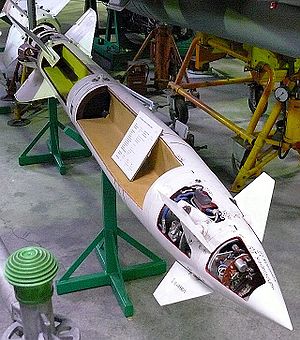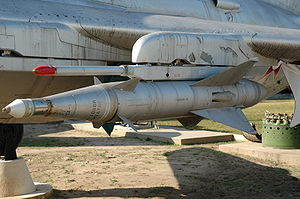avia.wikisort.org - Weapon
The Zvezda Kh-66 and Kh-23 Grom (Russian: Х-23 Гром 'Thunder'; NATO: AS-7 'Kerry') are a family of early Soviet tactical air-to-surface missiles with a range of 10 km. They were intended for use against small ground or naval targets. The Kh-66 was effectively a heavy-warhead, beam-riding version of the K-8 (AA-3 'Anab') air-to-air missile rushed into service in Vietnam in 1968. The Kh-23 was an improved Kh-66 with command-guidance, similar to the AGM-12 Bullpup.
| Kh-66/Kh-23 Grom (NATO reporting name: AS-7 'Kerry') | |
|---|---|
 AS-7 'Kerry' | |
| Type | Tactical air-to-surface missile |
| Place of origin | Soviet Union |
| Service history | |
| In service | Kh-66 :20 June 1968[1] Kh-23 :1973[2] Kh-23M :1974[2] |
| Used by | FSU, Warsaw Pact, Iraq, India[3] |
| Production history | |
| Designer | Yurii N. Korolyov[1] |
| Manufacturer | Zvezda-Strela |
| Specifications | |
| Mass | A921 :287 kg (633 lb)[3] |
| Length | A921 :3.525 m (11 ft 7 in)[3] |
| Diameter | 27.5 cm (10.8 in)[3] |
| Warhead weight | 111 kg (245 lb)[3] |
| Engine | Solid fuel rocket[3] |
| Wingspan | 78.5 cm (2 ft 6.9 in)[3] |
Operational range | 2–10 km (1.1–5.4 nmi)[3] |
| Maximum speed | 2,160–2,700 km/h (1,340–1,680 mph)[3] |
Guidance system | Kh-66 :Line-Of-Sight Beam riding Kh-23 :Radio command guidance Grom-B :TV guidance |
Launch platform | MiG-21PFM, MiG-23, MiG-27, Su-17M3/20/22/22M3/M4,[3] |

Development
Work on air-to-air missiles had started at the Kaliningrad Engineering Plant (then known as Plant #455, and later merged into Zvezda-Strela) in 1955.[1] This had resulted in the Kaliningrad K-5 (AA-1 'Alkali') family of beam-guided missiles, including the K-51 (RS-2-US) carried by the Su-9 'Fishpot'. OKB-4 Molniya (later Vympel NPO) under Matus Bisnovat would go on to produce missiles such as the AA-6 Acrid.[1] Meanwhile, in 1963 the RS-2-US was tested as an air-to-surface missile.[1] It was concluded that the small warhead and inaccurate guidance made such an application "pointless".[1]
However, in 1965 North Vietnam requested an air-to-surface missile from the Soviet government;[1] the AGM-12 Bullpup had entered service with the US Air Force before the start of the Vietnam War. In April 1965 OKB-134 (later NPO Vympel) started work on this missile under the project name Kh-23, but they had problems developing a guidance system that would work with existing aircraft.[3] As a result, Yurii N. Korolyov came up with his own proposals based on the earlier experiments with the RS-2-US. A design bureau to develop the RS-2-US for surface targets was set up under Korolyov by decree #100 of 12 March 1966 of the Ministry of the Aircraft Industry;[1] this bureau would become the Zvezda OKB in 1976.[4]
The resulting weapon used the body of a K-8 (AA-3 'Anab') K-5 guidance and propulsion systems but increased the warhead from 13 kg (29 lb) to 100 kg (220 lb).[5] This had the big advantage of allowing the new weapon to be fitted to any aircraft capable of firing the K-5.[3] Design began in 1966,[4] so the project was known as Kh-66 or Izdeliye 66 ('Article 66'). The Kh-66 was a beam-riding weapon that was tested on a MiG-21PFM[4] and entered production in 1968 for that aircraft. The Kh-66 was only an interim solution as it required the launch aircraft to dive towards the target to maintain lock on the target. Flight testing of the Kh-66 began in 1967[1] and it entered service on 20 June 1968.[1]
Meanwhile, Korolyov took over work on the Kh-23 project intended for carriage on the Soviet Union's new MiG-23.[3] The Kh-23 became a development of the Kh-66 design with an improved propellant and new Delta-R1M guidance system.[3] The main practical difference was that it was a line-of-sight radio-command weapon similar to the Bullpup, allowing it to be fired in level flight (unlike the Kh-66). The first ten were tested in early 1968,[3] but significant delays were caused by problems with unreliable guidance which was eventually traced to the smoke generator which interfered with the antenna.[3] Once the receiver had been moved to a tail extension,[3] the government tested the missile on the MiG-23 and MiG-23B between 20 March 1970 and 3 October 1973.[1] and it entered service in 1973.[2] A laser-guided version of the Kh-23, the Kh-25, became the basis for the AS-10 'Karen' family of missiles.[1] Technology from these was 'backported' to the Kh-23 to create the Kh-23M in 1974.[2]
The Kh-23 was later licensed for local production in both Romania and Yugoslavia.[3] In 1977 a dummy Kh-23 was fired from a Ka-252TB helicopter,[1] the prototype of the Kamov Ka-29TB 'Helix-B' assault transport.
Design
The Kh-66 used the airframe of the Kaliningrad K-8 (AA-3 'Anab') air-to-air missile, with the nozzle split to make room for the antenna of the beam-riding guidance system of the Kaliningrad K-5 (AA-1 'Alkali').[3] It has cruciform control fins on the nose, and four clipped-tip delta-wings at the rear with elevators for control.
Operational history
The Kh-66 entered production for the MiG-21 in 1968, and the Kh-23 was certified for the MiG-23 'Flogger' in 1973.
Variants

- Kh-66 - the original beam-riding missile based on the K-8
- Kh-23 (Izdeliye 68)[4] - First command-guidance version with improved propellant
- Kh-23M - improved Kh-23 with technology from the Kh-25 family[2]
- Kh-23L - Western name for a laser-guided version that in fact was the baseline Kh-25 (AS-10 'Karen')[4]
- A921 - Version made in Romania[3]
- Grom (Grom 02) - Yugoslav version that appeared in the 1980s.[6] This should not be confused with the Polish SAM
- Grom-B (Grom 2) - TV-guided version from Serbia's Vojno-Tehnički Institut in the mid-late 1990s; uses seeker based on that of the AGM-65B Maverick[6]
Operators

 North Korea [citation needed]
North Korea [citation needed] Syria[7]
Syria[7]
Former operators
 Bulgaria[3]
Bulgaria[3] Cuba
Cuba India[3]
India[3] Iraq[3]
Iraq[3] Libya[8]
Libya[8] Poland[3]
Poland[3] Romania (A921)[3]
Romania (A921)[3] Serbia (Grom)[3]
Serbia (Grom)[3] Soviet Union[3] - passed on to successor states
Soviet Union[3] - passed on to successor states Vietnam[citation needed]
Vietnam[citation needed]
Similar weapons
- AGM-12 Bullpup
- AS-20 - French air-to-ground missile based on an early air-to-air missile
Notes
- History of JSC Tactical Missile Corporation, pp. 3–4, archived from the original (Word 97 DOC) on 2011-07-27, retrieved 2009-02-15
- "Russian Air-to-Ground Missile Update", Jane's Missiles and Rockets, 1998-02-01, retrieved 2009-02-18
- Friedman, Norman (1997), The Naval Institute Guide to World Naval Weapons Systems, Naval Institute Press, p. 235, ISBN 978-1-55750-268-1
- "Kh-23, Kh-66 Grom (AS-7 'Kerry')", Jane's Air-Launched Weapons, 2008-08-01[dead link]
- FAS, Zvezda Kh-23 (AS-7 Kerry), retrieved 2007-04-15
- "Serbia and Montenegro develops 'smart' strike weapons", Jane's Missiles and Rockets, 2005-05-12, archived from the original on August 24, 2005, retrieved 2009-02-18
- Cooper 2018, p. 64
- Cooper 2018, p. 16
References
- Cooper, Tom (2018). MiG-23 Flogger in the Middle East, Mikoyan i Gurevich MiG-23 in Service in Algeria, Egypt, Iraq, Libya and Syria, 1973-2018. Warwick: Helion & Company Publishing. ISBN 978-1-912-390328.
- Gordon, Yefim (2004), Soviet/Russian Aircraft Weapons Since World War Two, Hinckley, England: Midland Publishing, ISBN 1-85780-188-1
На других языках
[de] Ch-23
Die Ch-23 (NATO-Codename AS-7 Kerry) ist eine taktische Luft-Boden-Lenkwaffe aus sowjetischer Produktion.- [en] Kh-23 Grom
[fr] Kh-23
Les missiles Kh-66, Kh-23 et Grom (en russe : « Х-23 Гром », tonnerre), nom de code OTAN : AS-7 « Kerry », sont une famille d'anciens missiles air-sol tactiques soviétiques, d'une portée de 10 km.[it] Kh-23
Il Kh-23 (nome in codice NATO: AS-7 Kerry) è un missile tattico aria-superficie sovietico sviluppato a partire dagli anni sessanta. Entrato in servizio negli anni settanta, costituì la base per il successivo e più perfezionato AS-10 Karen.[ru] Х-23
Х-66 и Х-23 (по кодификации НАТО — AS-7 Kerry) — советские тактические управляемые ракеты класса «воздух-поверхность» дальностью порядка 10 км разработки КБ завода № 455 в Калининграде (позднее ОКБ «Звезда»[1]). Предназначались для уничтожения небольших наземных и морских объектов.Другой контент может иметь иную лицензию. Перед использованием материалов сайта WikiSort.org внимательно изучите правила лицензирования конкретных элементов наполнения сайта.
WikiSort.org - проект по пересортировке и дополнению контента Википедии